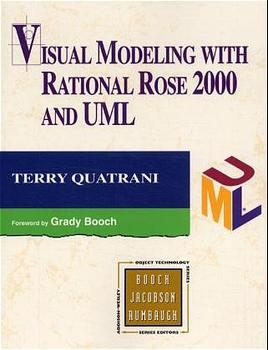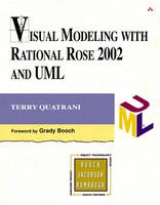
Visual Modeling with Rational Rose 2000 and UML
Addison Wesley (Verlag)
978-0-201-69961-6 (ISBN)
- Titel erscheint in neuer Auflage
- Artikel merken
The Unified Modeling Language (UML) offers standard semantics and notation for describing object structure and behavior and has emerged as the design medium of choice for developing large-scale distributed object applications. Augmented by the Rational Unified Process, an extensive set of software development guidelines, and the Rational Rose visual modeling tool, the UML greatly facilitates the development of quality object-oriented applications that meet both deadlines and requirements. Visual Modeling with Rational Rose 2000 and UML is a comprehensive introduction and tutorial providing guidance on how to use a tool (Rational Rose 2000), a process (the Rational Unified Process), and a language (the UML) to successfully visualize, specify, document, and construct a software system. Written by the Rose Evangelist at Rational Software Corporation, a leader in UML and object technology, this book breaks the technology down to its essentials and provides clear explanations of each element. It follows a simplified version of the Rational Unified Process from project inception through system analysis and design.
A sample case study running throughout the book illustrates this iterative development process, the UML in practice, and the application of Rational Rose. New appendices demonstrate code generation and reverse engineering using Rational Rose 2000 with the Visual C++, C++, and Visual Basic languages. Topics covered include: *Creating use cases *Finding objects and classes *UML stereotypes and packages *Scenarios, sequence diagrams, and collaboration diagrams *Discovering object interaction *Specifying relationships, association, and aggregation *Adding behavior and structure *Superclass/subclass relationships and inheritance *Object behavior and Harel state transition diagrams *Checking for model consistency *Specifying, visualizing, and documenting system architecture *The iteration planning process 0201699613B04062001
Terry Quatrani, IBM Rational’s UML Evangelist, is responsible for training and transitioning Fortune 500 companies to object technology and for preaching the visual modeling gospel of Grady Booch, Jim Rumbaugh, and Ivar Jacobson. She has spent twenty-one years developing and deploying large software systems. Formerly at GE, she was founding consultant for the Lockheed Martin Advanced Concepts Center.
Foreword.
Preface.
1. Introduction.
What Is Visual Modeling?
The Triangle for Success.
The Role of Notation.
History of the UML.
The Role of Process.
What Is Iterative and Incremental Development?
The Rational Unified Process.
The Rational Rose Tool.
Summary.
2. Beginning a Project.
Defining the Right Project.
Eastern State University (ESU) Background.
Risks for the Course Registration Problem.
ESU Course Registration Problem Statement.
Summary.
3. Creating Use Cases.
System Behavior.
Actors.
Use Cases.
Use Case Relationships.
Use Case Diagrams.
Activity Diagrams.
Summary.
4. Finding Classes.
What Is an Object?
State, Behavior, and Identity.
What Is a Class?
Stereotypes and Classes.
Discovering Classes.
Documenting Classes.
Packages.
Objects and Classes in the ESU Course Registration Problem.
Class Diagrams.
Summary.
5. Discovering Object Interaction.
Use Case Realization.
Documenting Scenarios.
Sequence Diagrams.
Sequence Diagrams and Boundary Classes.
Complexity and Sequence Diagrams.
Collaboration Diagrams.
Why Are There Two Different Diagrams?
Sequence Diagram for the ESU Course Registration System.
Summary.
6. Specifying Relationships.
The Need for Relationships.
Association Relationships.
Aggregation Relationships.
Association or Aggregation?
Naming Relationships.
Role Names.
Multiplicity Indicators.
Reflexive Relationships.
Finding Relationships.
Package Relationships.
Summary.
7. Adding Behavior and Structure.
Representing Behavior and Structure.
Creating Operations.
Documenting Operations.
Relationships and Operation Signatures.
Creating Attributes.
Documenting Attributes.
Displaying Attributes and Operations.
Association Classes.
Summary.
8. Discovering Inheritance.
Inheritance.
Generalization.
Specialization.
Inheritance Trees.
Single Inheritance versus Multiple Inheritance.
Inheritance versus Aggregation.
Summary.
9. Analyzing Object Behavior.
Modeling Dynamic Behavior.
States.
State Transitions.
Special States.
State Transition Details.
State Details.
Summary.
10. Checking the Model.
Why Homogenize?
Combining Classes.
Splitting Classes.
Eliminating Classes.
Consistency Checking.
Scenario Walk-Through.
Event Tracing.
Documentation Review.
Summary.
11. Designing the System Architecture.
The Need for Architecture.
The Architecture Team.
The 4+1 View of Architecture.
The Logical View.
The Implementation View.
The Process View.
The Deployment View.
The Use Case View.
Summary.
12. Building the Iterations.
The Iteration Planning Process.
Designing the User Interface.
Adding Design Classes.
The Emergence of Patterns.
Designing Relationships.
Designing Attributes and Operations.
Designing for Inheritance.
Coding, Testing, and Documenting the Iteration.
Using Reverse Engineering to Set the Stage for the Next Iteration.
Summary.
Appendix A.
Code Generation and Reverse Engineering with C++.
Appendix B.
Code Generation and Reverse Engineering with Visual C++ and Visual Basic.
Appendix C.
A Visual Basic Example.
Glossary.
Index. 0201699613T04062001
| Erscheint lt. Verlag | 29.11.1999 |
|---|---|
| Verlagsort | Boston |
| Sprache | englisch |
| Maße | 179 x 228 mm |
| Gewicht | 550 g |
| Themenwelt | Informatik ► Software Entwicklung ► Objektorientierung |
| ISBN-10 | 0-201-69961-3 / 0201699613 |
| ISBN-13 | 978-0-201-69961-6 / 9780201699616 |
| Zustand | Neuware |
| Informationen gemäß Produktsicherheitsverordnung (GPSR) | |
| Haben Sie eine Frage zum Produkt? |
aus dem Bereich



